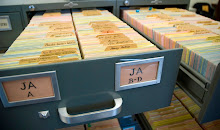In the Adams Paper slip file, the chronological run is considered the master and it is that which was microfilmed and used to create the digital control file. In adding document types, which was based on an equally impressive alphabetical run (which includes, for the prominent Adamses , a select list of subjects) it was determined that some slips were present in the alpha run and not in the chronological run. These were goldenrod slips, which are used in house as cross-reference slips to connect people, places, subjects, correspondence, etc. Probably a lot more. The current task to which I have been assigned is going through the slips in the Alphabetical run and identifying those slips of goldenrod color that were not also present in the chronological run. The process includes making copies of those slips not found and then adding them to the Digital Control File.
Before this, when creating a new slip one would find a slip of similar color, copy it, and then edit to suite. Now, though, we have a new option in the interface that enables us to create a new slip from scratch. A most helpful part of the tool.
Another project that is ongoing at the time - thought not being completed by the contributing members of this blog - is that updates and changes to existing slips is taking place. There is a big three-ringed binder of these changes. A process that took heaps of time in its analog format is now being completed quite a bit more swiftly. This is not always easy and has involved some collaboration between the Adams staff and the control file gurus, some instruction, and the detection & correction of bugs.

